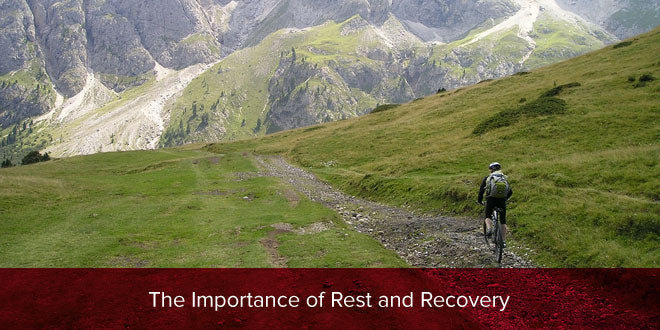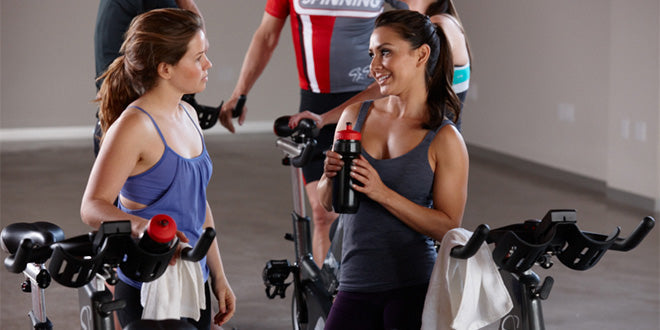Submitted by Linda FreemanWhether you take Spinning® classes, go mountain biking, road cycling, or even riding cross-country, you must include rest and recovery in your training plans if you want to experience the full benefits of your efforts. It is during times of recovery that fitness and performance gains are realized.Recovery and rest cover a broader aspect of total-balanced training than simply dedicating one Spinning class a week to recovery or practicing recovery from hard intervals in an Interval Energy Zone™ ride. Recreational and performance athletes are wise to periodize their year of training. Many athletes dedicate an entire month to recovery and rest. This doesn’t mean lie on the sofa and watch TV for 30 straight days. Athletes deliberately plan a period of healing, regeneration and renewal, followed by an equally important ladder of training from base-building to the dynamic. It is not on the day that we stretch our limits with a Race Day Energy Zone™ class that we increase our strength, but on the subsequent day of recovery. That’s when the benefits kick in.In his book Cycling Past 50, Joe Friel writes, “Restoration is a moving target. It’s imperative to get it right.” Effective recovery is highly individualized. The trick may be in the pre-programmed recovery period in an annual training plan. Waiting for fatigue is both unwise and unnecessary. “Fatigue is both friend and foe,” Friel says. “A purpose of training is to delay the onset of fatigue while improving the ability to cope with it. On the other hand, fatigue prevents a physiological catastrophe.”Interestingly enough, recovery might be the most challenging aspect of training, though it is also the most important. Without it, progress reverts to degeneration, physical skills dull, and the mental and emotional component of exercise shuts down. At best, degeneration can lead to undoing much of the good achieved during the preceding months of diligent training, or at worst, it can make you want to give up entirely.There are three ways to rest and recover: therapeutic rest, passive rest and active rest. Therapeutic rest emphasizes sleep, a time of repair and growth. When teaching my Spinning classes, I often use the analogy of a sponge. We enter the studio highly motivated, well-fueled and full of energy. By the end of class, we are wrung out like a sponge that has had every drop of water squeezed out of it. During recovery, we put that sponge into a basin of cool water and gradually the sponge soaks up all that nourishment and returns to form, perhaps even more dense and expansive than before. During sleep, our bodies recover in a similar way.Passive rest is taking a break from regular training. It is time away during which we allow the body to function at a moderate pace and enjoy the simple pleasures and achievements of our training. It is also an ideal time to recover mentally and decompress from a strict training schedule.Active rest is where the fun begins. This is a time to enjoy other sports and activities. It is a time to notice the restoring energy and enthusiasm with which you begin each day. It’s okay to flex your muscles and joints, but don’t be demanding during this time.As Spinning instructors, we must factor recovery into the training programs of our students. Riders have total control over their Spinner® bikes and can create their own terrain and intensity. Guiding our classes through periodized training is more complex. Not everyone is on the same schedule or shares the same goals. However, an annual plan is generically achievable. Let me share my personal strategies with you and show you how I adapt them to my classes.I live in Vermont and teach Spinning classes year-round. I also ride outdoors during our short cycling season from late spring to early or mid-autumn. January is a time for base-building, leading up to certain events like the 6-hour Spinning fundraiser for the Vermont Special Olympics in the spring, as well as four or more centuries or other organized rides during the cycling season in the summer. The fall and winter are a great time to work in recovery. I spend two weeks passively, during which I work with my personal training clients and teach my Spinning classes, often off the bike. I add some Endurance Energy Zone™ classes and head into the holiday season hoping to get outdoors to snowshoe, cross-country ski and enjoy the company of active friends and family, keeping my participation at a modest, recreational level. As I get closer to January, I re-evaluate to be sure I have achieved true recovery and enjoy my increasingly active rest.A Spinning class parallel may include the build-up of Endurance Energy Zone training in January and February, followed by Strength Energy Zone™ and Interval Energy Zone classes in the subsequent months, including longer rides and classes as the months continue. Summer would include cycling outdoors, during which Spinning classes continue in the aerobic energy system and active recovery. Students returning to the studio following a summer of outdoor riding are usually ready to train hard during the early months of the fall. By Thanksgiving, personal chores and holiday demands may get in the way of students’ workout regimen and a recovery period fits in there as well.There’s a difference between purposeful exercise and lifestyle activity, between active and passive recovery, between motivation and compulsion and between laziness and burnout. As Spinning instructors, we have the tools and the guidance to make the difference. Build recovery and active rest into your weekly and yearly training schedule. And, of course, don’t forget to play and enjoy the results of your hard work!






Leave a comment
This site is protected by hCaptcha and the hCaptcha Privacy Policy and Terms of Service apply.